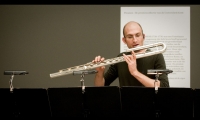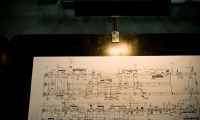MNEMOSYNE
Piece for bass flute and pre-recorded tape
by Brian Ferneyhough, 1986,
performed by Michael Schmid
Pre-recorded tape : Michael Schmid
Museum voor Schone Kunsten, Gent, 2008,
Piranesi Exhibition
(Giambattista Piranesi, 1720-1778)
(Programme note by Paul Griffiths)
MNEMOSYNE forms the seventh and final stage in Ferneyhough’s Carceri d’invenzione cycle, and together with the Intermedio alla ciaccona for solo violin that occupies third place, was completed almost at the last moment. Both works are dated “Freiburg, September 1986”, which was the month before the first complete performance of the cycle, at the Donaueschingen Musiktage, when Roberto Fabbriciani was the flautist; neither piece was played before that occasion. Like the Intermedio_and _Carceri d’invenzione III, Mnemosyne was commissioned by South West German Radio.
Mnemosyne is, in Greek mythology, the goddess of memory and mother of the muses. What this Mnemosyne remembers is the underlying substance of a previous hour and a quarter of music, constituted by the other parts of the Carceri sequence. According to the composer, “the chordal patterns varied in the preceding six pieces are again spread out here... as an omnipresent background which serves to bring into play or extend earlier «harmonic spaces», and also to make available a discreet but constantly present series of focal notes around which the soloist weaves a limited number of intervallic chains, themselves derived from the eight initial chords and having strong internal relationships. The richer the sonority of this background it increases from four to eight parts the greater the scope for flexibility in the melodic variations. However, since in the final section of the composition the number of derived intervals is greatly reduced, the sonic gestures of the bass flute are increasingly «hemmed in», «imprisoned», until finally the process inevitably leads to a fade-out”.
The slow weave of chords on tape was composed first, but since this material is played also on bass flutes, and since it arrives only after the live instrument has summoned it, the bass flute we see seems to be exploring, to the limits, a prison of its own making, a prison of mirrors. “It’s a sort of cathedral-under-the-sea sound”, Ferneyhough has also said, “rather like the Debussy prelude, in which everything is moving in slow motion, and it is reduced to a lower octave level, like a tape being played slowly”. The cycle had begun with a solo for piccolo, Superscriptio, and had moved on through pieces featuring flute and alto flute; its conclusion in the bottom register a conclusion continuing in the face of silence from the various Carceri formations (a modern-music ensemble, a classical chamber orchestra, a mixed quintet, a band of wind and percussion) makes a desolate exit.
Heard by itself, Mnemosyne may evoke other contexts as the last so far, for instance, in a line of works Ferneyhough has written for his own instrument, beginning with Four Miniatures for Flute and Piano (1965) and going on through Cassandra’s Dream Song (1970), Unity Capsule (1975–76) and Superscriptio (1981). Following these, it might seem a further investigation of nuances of time (for which purpose the player needs to hear a click track over headphones) and timbre less a prison than a careful, testing survey of previously uninhabited territory.

